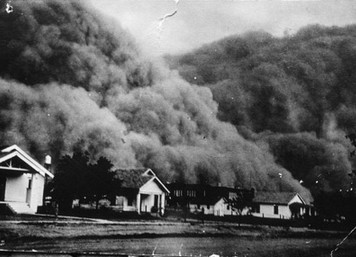Leaving the Southern Plains
The southern Plains experienced a terrible drought during the early 1930s. Intense heat accompanied the drought. In the summer of 1934, Oklahoma reached 117 degrees on July 24, the 36th day in a row that it had been above 100 degrees. Fields and rivers dried up, and clouds of grasshoppers ate what was left of the wheat and corn. According to one Weather Bureau scientist, the drought of the ’30s was “the worst in the climatological history of the country.”
Drought was not the only cause of the westward movement of farmers and sharecroppers from the southern Plains. When prices fell because of oversupply following the end of World War I, many farmers lost their farms and became tenants or sharecroppers. As more and more farms were cultivated with tractors, the tenants and farm laborers lost their jobs, because tractors were much more efficient. And as the soil was tilled and retilled, it lost its fertility. Worn out, it lay naked and unprotected from raging winds.
In 1934, windstorms ravaged the Plains states. The incredible storms sent clouds of dust as far as Chicago, New York, and Boston. In 1935, the storms became even worse. For six weeks in March and early April, it was unusual to see a clear sky from dawn to dusk anywhere in the Plains states. In Kansas, 12 consecutive days of dust storms raged in March. One Kansas resident wrote in her diary: “This is the ultimate darkness. So must come the end of the world.” But in fact, it got worse. On April 14—“ Black Sunday”—a deadly storm turned day into night. The storms resulted in more farms failing and more people out of work. Desperately poor, people began an exodus from the Dust Bowl.
Disrupting the Borg is expensive and time consuming!
Google Search
-
Recent Posts
- Fact Checking NASA
- Fact Checking Grok
- Fact Checking The New York Times
- New Visitech Features
- Ice-Free Arctic By 2014
- Debt-Free US Treasury Forecast
- Analyzing Big City Crime (Part 2)
- Analyzing Big City Crime
- UK Migration Caused By Global Warming
- Climate Attribution In Greece
- “Brown: ’50 days to save world'”
- The Catastrophic Influence of Bovine Methane Emissions on Extraterrestrial Climate Patterns
- Posting On X
- Seventeen Years Of Fun
- The Importance Of Good Tools
- Temperature Shifts At Blue Hill, MA
- CO2²
- Time Of Observation Bias
- Climate Scamming For Profit
- Climate Scamming For Profit
- Back To The Future
- “records going back to 1961”
- Analyzing Rainfall At Asheville
- Historical Weather Analysis With Visitech
- “American Summers Are Starting to Feel Like Winter”
Recent Comments
- Bob G on Fact Checking NASA
- Bob G on Fact Checking NASA
- arn on Fact Checking NASA
- Gordon Vigurs on Fact Checking NASA
- Bob G on Fact Checking NASA
- Bob G on Fact Checking NASA
- arn on Fact Checking NASA
- conrad ziefle on Fact Checking NASA
- conrad ziefle on Fact Checking NASA
- arn on Fact Checking NASA



Just a myth created by Steinbeck.